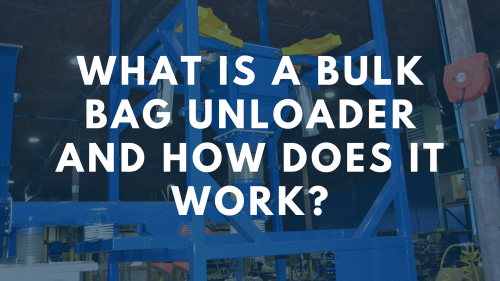What is a Bulk Bag Unloader and How Does It Work?
Bulk bag unloaders are essential systems for efficiently and safely discharging dry bulk materials stored in flexible intermediate bulk containers (FIBCs), commonly referred to as bulk bags. Whether handling powders, granules, or pellets, a bulk bag unloader streamlines the emptying process, improves worker safety, and minimizes material loss.
In industries ranging from food processing to construction materials, bulk bag unloaders are critical for moving raw materials into downstream production without spillage, dusting, or manual handling errors. Understanding how these systems work—and what features to look for—can help ensure you select the right solution for your operations.
What is a Bulk Bag Unloader?
A bulk bag unloader is a mechanical system designed to support and discharge the contents of large bulk bags in a controlled, efficient manner. Bulk bags can weigh anywhere from 500 to 4,000 pounds, making it critical to have the right equipment to manage unloading safely.
Typically, a bulk bag unloader consists of a heavy-duty frame, a support structure for the bag, and a discharge spout or hopper that connects to downstream equipment like conveyors, mixers, or storage bins. Some unloaders are simple and manual, while others offer highly engineered designs with features like dust containment, massaging paddles, and integrated flow aids.
Key Components of a Bulk Bag Unloader
While designs can vary depending on the specific application, most bulk bag unloaders include several core components:
Bag Support Frame
A strong steel frame holds the suspended bulk bag securely during unloading.
Forklift Lifting or Hoist System
Allows operators to lift and position the bulk bag safely into place.
Discharge Spout Access
The bottom of the bulk bag is connected to a spout enclosure where the material flows out.
Flow Aids
Devices like bag massagers or vibrators help promote consistent material flow, especially for sticky or compacted materials.
Dust Control Systems
Optional features like dust-tight spout interfaces or integrated filtration systems reduce airborne dust during unloading.
Integrated Control Panels
Some systems include electronic controls for flow rate adjustment, safety interlocks, or automated operation.
How Does a Bulk Bag Unloader Work?
The unloading process typically follows these steps:
-
Bag Loading
A full bulk bag is lifted using a forklift or hoist and positioned on the unloader's frame. The bag loops are secured to support arms or hooks. -
Spout Connection
The discharge spout of the bulk bag is connected to the spout interface of the unloader. This connection may involve clamping systems to create a dust-tight seal. -
Flow Activation
The material flow is initiated either manually (by opening the bag's discharge spout) or automatically via integrated systems. -
Controlled Discharge
Material flows by gravity into the receiving vessel, conveyor, or downstream process. Flow aids like bag massagers or agitation devices ensure consistent flow. -
Completion and Cleanup
After the bag is emptied, the frame is cleared, and the next bag can be loaded.
Industries That Rely on Bulk Bag Unloaders
Bulk bag unloaders are used across a wide range of industries, including:
-
Food and beverage processing – ingredients like flour, sugar, and spices
-
Chemical manufacturing – powders, resins, specialty chemicals
-
Construction materials – cement, sand, dry aggregates
-
Agriculture – seeds, fertilizers, and feedstocks
-
Plastics and resins – pellets and powders for production
Each industry has specific requirements regarding hygiene, dust containment, flow rate, and regulatory compliance—making it important to select the right equipment for the application.
Benefits of Using a Bulk Bag Unloader
-
Increased efficiency through faster, more consistent unloading
-
Improved worker safety by eliminating manual lifting
-
Reduced dust and spill risk, improving facility cleanliness
-
Full material discharge to reduce waste and improve yield
-
Integration options with downstream processing equipment
Selecting the Right Bulk Bag Unloader
When choosing a bulk bag unloader, consider the following:
-
Material flow characteristics (free-flowing vs. non-free-flowing)
-
Bulk bag sizes and average weights
-
Required discharge rates
-
Available facility space and ceiling height
-
Need for dust containment or automation features
Working with a trusted equipment provider ensures you receive a system designed specifically for your materials and process requirements.
Contact Erie Technical Systems
Erie Technical Systems offers a range of bulk bag unloading solutions tailored to your unique material handling needs. Our unloaders are engineered for durability, safety, and performance—helping your operation run more efficiently and reliably.
Visit www.erietechnicalsystems.com to learn more or contact our team directly to discuss your application.

